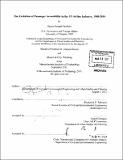| dc.contributor.advisor | Frederick P. Salvucci. | en_US |
| dc.contributor.author | Jenkins, James Joseph, M.C.P. Massachusetts Institute of Technology | en_US |
| dc.contributor.other | Massachusetts Institute of Technology. Dept. of Urban Studies and Planning. | en_US |
| dc.coverage.spatial | n-us--- | en_US |
| dc.date.accessioned | 2012-05-15T21:10:53Z | |
| dc.date.available | 2012-05-15T21:10:53Z | |
| dc.date.copyright | 2011 | en_US |
| dc.date.issued | 2011 | en_US |
| dc.identifier.uri | http://hdl.handle.net/1721.1/70768 | |
| dc.description | Thesis (S.M. in Transportation)--Massachusetts Institute of Technology, Dept. of Civil and Environmental Engineering; and, (M.C.P.)--Massachusetts Institute of Technology, Dept. of Urban Studies and Planning, 2011. | en_US |
| dc.description | Cataloged from PDF version of thesis. | en_US |
| dc.description | Includes bibliographical references (p. 178-185). | en_US |
| dc.description.abstract | Since deregulation, passenger air travel and the airline industry as a whole have changed dramatically. While most previous research has focused on the changes experienced by the airlines, this thesis seeks to understand the effects of industry changes on passenger accessibility. This work develops a methodology to quantitatively measure accessibility changes and then applies the methodology to the Bureau of Transportation Statistics' DBIB dataset, a 10% sample of all tickets purchased in the United States. The analysis reviews changes in accessibility based on 4 measures: a new path quality measure, passenger volume, circuity, and fares at all continental US Primary and Commercial Service airports. The results indicate that between 1980 and 2010 accessibility declined in terms of path quality and circuity, but those declines were offset by accessibility increases in terms of lower fares which resulted in increased passenger volume. While the primary analysis was aggregated by FAA airport size classifications, the methodology can also be used at a regional scale. This is demonstrated through a case study of the 3 largest airports in the Boston region which have developed symbiotically despite having overlapping catchment areas. The results yield insights that would otherwise be missed in a higher level analysis and highlight the importance of regional analysis to understanding passenger accessibility. The thesis also uses the methodology and data to examine the effects of industry changes on rural communities by looking at the Essential Air Service program, which subsidizes air service to rural communities. The analysis found that the program has performed well in terms of preserving rural air accessibility but that certain program regulations make the program financially inefficient. Several changes are proposed to improve the program's effectiveness and value to passengers. Finally, the analysis looks towards the future and the extension of this work as a foundation for thinking about how to improve passenger accessibility while dealing with the challenges facing the industry including financial instability, airport congestion, the potential for partial re-regulation, future changes in the network structure, and potential reduction in EAS funding. | en_US |
| dc.description.statementofresponsibility | by James Joseph Jenkins. | en_US |
| dc.format.extent | 185 p. | en_US |
| dc.language.iso | eng | en_US |
| dc.publisher | Massachusetts Institute of Technology | en_US |
| dc.rights | M.I.T. theses are protected by
copyright. They may be viewed from this source for any purpose, but
reproduction or distribution in any format is prohibited without written
permission. See provided URL for inquiries about permission. | en_US |
| dc.rights.uri | http://dspace.mit.edu/handle/1721.1/7582 | en_US |
| dc.subject | Civil and Environmental Engineering. | en_US |
| dc.subject | Urban Studies and Planning. | en_US |
| dc.title | The evolution of passenger accessibility in the US airline industry, 1980-2010 | en_US |
| dc.type | Thesis | en_US |
| dc.description.degree | M.C.P. | en_US |
| dc.description.degree | S.M.in Transportation | en_US |
| dc.contributor.department | Massachusetts Institute of Technology. Department of Civil and Environmental Engineering | |
| dc.contributor.department | Massachusetts Institute of Technology. Department of Urban Studies and Planning | |
| dc.identifier.oclc | 790359172 | en_US |
